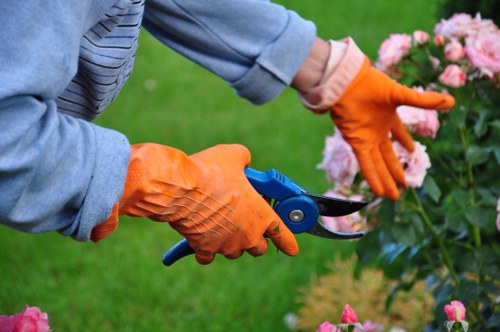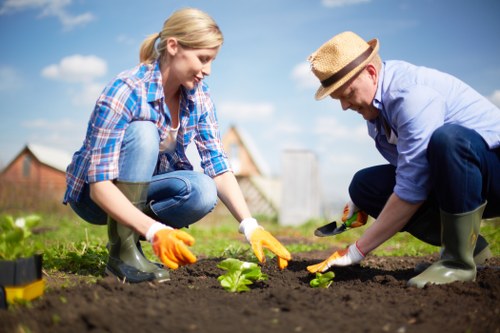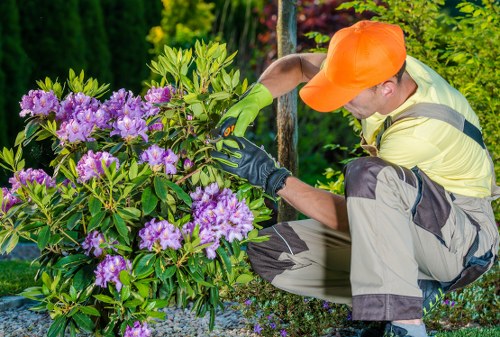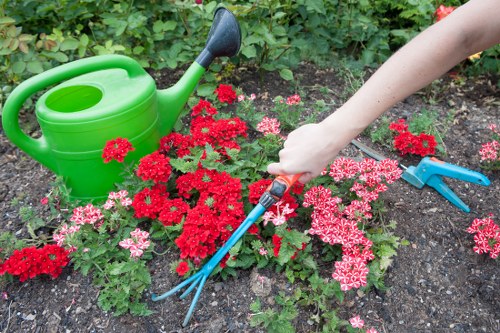Comprehensive Guide to Garden Maintenance in Neasden

Introduction to Garden Maintenance
Maintaining a beautiful garden in Neasden requires dedication, knowledge, and the right set of tools. Whether you're a seasoned gardener or a beginner, understanding the fundamentals of garden upkeep can transform your outdoor space into a vibrant and thriving environment.
In Neasden, the climate and local conditions play a significant role in determining the best practices for garden maintenance. This article delves into the essential aspects of keeping your garden in top shape throughout the year.
From soil preparation to plant selection and regular upkeep, we'll cover everything you need to know to ensure your garden flourishes.

Understanding the Local Climate
Neasden experiences a temperate climate, characterized by mild summers and cool winters. This climate influences the types of plants that thrive and the maintenance routines you'll need to adopt.
Key Climate Factors:
- **Temperature Variations**: Understanding seasonal temperature changes helps in selecting appropriate plants.
- **Rainfall Patterns**: Adequate watering strategies are essential, especially during drier months.
- **Sunlight Exposure**: Positioning plants based on sunlight can maximize growth and health.
By aligning your garden maintenance practices with Neasden's climate, you can ensure a resilient and lush garden all year round.

Soil Preparation and Management
Healthy soil is the foundation of a thriving garden. Proper soil preparation ensures that your plants receive the necessary nutrients and have a robust root system.
Testing Your Soil
Conducting a soil test helps determine its pH level, nutrient content, and composition. This information is crucial for making informed decisions about amendments and plant selection.
Steps to Test Soil:
- Collect samples from different parts of your garden.
- Use a soil testing kit or send samples to a local agricultural extension.
- Analyze the results and identify necessary soil amendments.

Improving Soil Quality
Enhancing soil quality involves adding organic matter, such as compost or manure, to increase fertility and structure.
Benefits of Organic Matter:
- **Nutrient Supply**: Provides essential nutrients for plant growth.
- **Water Retention**: Improves the soil's ability to retain moisture.
- **Soil Structure**: Enhances aeration and drainage.

Plant Selection and Care
Choosing the right plants is pivotal for the success of your garden. Consider factors such as climate suitability, soil preferences, and maintenance requirements.
Popular Plants in Neasden
Neasden gardens often feature a mix of perennials, annuals, shrubs, and trees that thrive in the local conditions.
- **Roses**: Known for their beauty and fragrance.
- **Lavender**: Appreciated for its scent and resilience.
- **Boxwood**: Used for creating structured hedges.
Planting Techniques
Proper planting techniques ensure that plants establish well and grow healthily.
Steps for Planting:
- Dig a hole twice the size of the root ball.
- Place the plant at the same depth it was in the nursery.
- Backfill with soil and firm gently.
- Water thoroughly after planting.
Regular Maintenance Practices
Consistent maintenance is essential for preventing issues and promoting plant health. Key practices include watering, pruning, weeding, and pest control.
Watering: Adjust your watering schedule based on plant needs and weather conditions.
- **Deep Watering**: Encourage deep root growth.
- **Morning Schedule**: Reduces evaporation and fungal risks.
Pruning: Regular pruning helps maintain plant shape and removes dead or diseased branches.
Weed Control
Weeds compete with your plants for nutrients and water. Implementing effective weed control methods is crucial.
Techniques:
- Manual Removal: Hand-pulling weeds to prevent regrowth.
- Mulching: Suppresses weed growth and retains soil moisture.
- Herbicides: Use cautiously to target persistent weeds.
Pest Management
Protecting your garden from pests ensures healthy plant growth. Adopt integrated pest management strategies for effective control.
- **Biological Controls**: Introduce natural predators to manage pest populations.
- **Organic Pesticides**: Use environmentally friendly options to minimize harm.
- **Regular Monitoring**: Early detection prevents severe infestations.
Seasonal Garden Care
Adapting your garden maintenance to the changing seasons enhances plant health and garden aesthetics.
Spring Maintenance
As the weather warms, prepare your garden for the growing season.
- **Pruning**: Trim damaged branches.
- **Planting**: Introduce new plants and flowers.
- **Fertilizing**: Boost soil nutrients for vigorous growth.
Summer Care
Manage heat stress and ensure adequate hydration for your plants.
Tips:
- Water early in the morning.
- Apply mulch to retain moisture.
- Provide shade for sensitive plants.

Autumn Preparations
Prepare your garden for winter by cleaning and protecting plants.
- **Cleaning**: Remove fallen leaves and debris.
- **Plant Protection**: Use covers or mulches to shield plants from frost.
- **Tool Maintenance**: Clean and store gardening tools properly.
Winter Care
While some plants go dormant, others require specific care to survive the cold months.
Strategies:
- **Mulching**: Insulate plant roots.
- **Pruning**: Remove dead branches to prevent damage.
- **Monitoring**: Check for signs of pests or diseases.
Choosing Professional Garden Maintenance Services
Sometimes, enlisting the help of professional garden maintenance services in Neasden can make a significant difference.
Benefits of Professional Services
Experts bring experience, specialized knowledge, and the right tools to ensure your garden is maintained effectively.
- **Time-Saving**: Professionals handle tasks efficiently.
- **Expertise**: Knowledge of local plants and conditions.
- **Comprehensive Care**: From planting to pest control.
How to Choose the Right Service
Consider factors such as reputation, range of services, and pricing when selecting a garden maintenance provider.
Tips:
- Read reviews and ask for references.
- Ensure they offer the specific services you need.
- Compare quotes to find a competitive price.
Tools and Equipment for Garden Maintenance
Having the right tools is essential for effective garden maintenance. Invest in quality equipment to make your gardening tasks easier and more efficient.
Essential Tools
- **Pruners**: For trimming and shaping plants.
- **Shovel and Spade**: For digging and planting.
- **Rake**: To gather leaves and debris.
Advanced Equipment
For larger gardens, consider investing in power tools like lawn mowers, leaf blowers, and irrigation systems.
Maintenance Tips:
- Regularly clean and sharpen tools.
- Store equipment in a dry, secure place.
- Inspect tools for damage before use.
Sustainable Garden Practices
Adopting sustainable practices not only benefits the environment but also enhances the health of your garden.
Composting
Recycling garden waste through composting enriches the soil naturally.
- **Reduces Waste**: Minimizes landfill contributions.
- **Enhances Soil**: Provides essential nutrients.
- **Improves Soil Structure**: Promotes better root growth.
Water Conservation
Implementing water-saving techniques ensures that your garden remains lush without excessive water use.
Methods:
- **Drip Irrigation**: Delivers water directly to plant roots.
- **Rainwater Harvesting**: Collects and stores rainwater for garden use.
- **Mulching**: Reduces evaporation and maintains soil moisture.

Enhancing Garden Aesthetics
Aesthetically pleasing gardens provide relaxation and beauty. Incorporate design elements to enhance the visual appeal of your garden.
Landscape Design
Plan your garden layout to create harmony and balance. Consider elements like pathways, seating areas, and focal points.
- **Pathways**: Guide visitors through your garden.
- **Seating Areas**: Create spaces for relaxation.
- **Focal Points**: Highlight specific plants or features.
Color Coordination
Select plants with complementary colors to create a cohesive look.
Tips:
- Choose a color palette that suits your taste.
- Mix perennials and annuals for varied colors.
- Use foliage plants to add texture and contrast.
Lighting
Proper lighting enhances the beauty of your garden during the evening hours.
- **Solar Lights**: Eco-friendly and easy to install.
- **String Lights**: Add a festive atmosphere.
- **Spotlights**: Highlight specific garden features.
Common Challenges in Garden Maintenance
Maintaining a garden comes with its set of challenges. Being aware of common issues helps you address them proactively.
Pest Infestations
Pests can damage plants and hinder growth. Regular monitoring and early intervention are key to managing infestations.
Disease Management
Fungal and bacterial diseases can spread quickly. Practice good hygiene and use resistant plant varieties to minimize risks.
Preventive Measures:
- Ensure proper plant spacing for air circulation.
- Avoid overhead watering to reduce moisture on leaves.
- Rotate crops to prevent soil-borne diseases.

Conclusion
Effective garden maintenance in Neasden involves understanding the local climate, preparing the soil, selecting the right plants, and adhering to regular upkeep practices. By implementing the strategies outlined in this guide, you can cultivate a beautiful and sustainable garden that thrives throughout the year.
Embrace the joy of gardening and transform your outdoor space into a lush, vibrant haven.
Ready to elevate your garden? Contact us today to book your garden maintenance service and watch your garden flourish!

